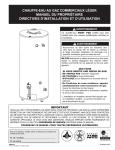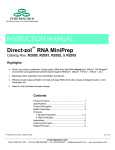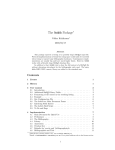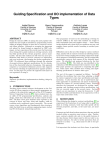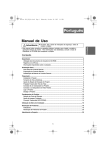Download Development of Formal Components using the B method
Transcript
Development of Formal Components using the B
method
Dorian Petit1,2 , Vincent Poirriez2, and Georges Mariano 1
?
1
2
INRETS ESTAS, 20, rue Élisée Reclus
F-59650 VILLENEUVE D’ASCQ - France,
[dorian.petit,georges.mariano]@inrets.fr,
Université de Valenciennes et du Hainaut Cambrésis, LAMIH/ROI,
F-59313 Valenciennes Cedex 9, France,
[dorian.petit,vincent.poirriez]@univ-valenciennes.fr
Abstract. The aim of this paper is to merge two approaches of software
development. The first one is the component approach. Developping software components is now a new challenge in the software industry. The
second approach is the formal one. These approaches are not so distant
if we consider Bertrand Meyer’s opinion: a component without contracts
can not be reused (more exactly, he said that it was more complicated
to reuse such a component). One of the difficulties with the design by
contract approach is to find the contracts. In some formal approach -we
will use the B method in this paper- the software properties (the contracts) are expressed in the specifications. We present in this paper a
tool we have developped to generate code in the spirit of the component
approach from B specifications. Thus, we will see how we can link the
notion of component and the B specifications.
1
Introduction
The use of formal methods in software development increase the quality and
the reliability of software. In some cases -when a dysfunction of the system
can lead to human or financial losses- formal methods should be used (see the
common criteria [1]). We will not tell more on this subject, because it was already
discussed in the literature ([2] and [3] for example).
The component-based development is an important approach in software
development. Some of the aims of this approach are near to those of formal
development. The common main advantage is that the quality of the software
increases: if you use a component-based approach to develop a software, you
focus on a piece of the software, and consequently you make less mistakes.
Bowen and Hinchey give in [4] some recommendations to use formal methods
in the industry. These recommendations are expressed in ten commandments.
Two of them are of particular interest for our work: the second and the ninth.
?
This work have been partially supported by the COLORS french project (COmposants LOgiciels Réutilisable et Sûr which means Reusable and Reliable Component
Software), a TACT 2000 project
35
36
Dorian Petit et al.
The second says : “Thou shalt formalize but not over-formalize”. This commandment expresses that it is “both unnecessary and costly” to apply formal
methods to all parts of a system. The authors speak about the “components of
the system that will benefit from a formal treatment”. The notion of component
seems to be natural when you use formal methods.
The ninth commandment says: “Thou shalt test, test, and test again”. Even
if a formal method is used to develop all the system, it is necessary to test.
Considering more “traditional” (as opposed to formal) development methods,
a new approach seems to be interesting: “design by contract”. This approach is
based on adding assertions in the software. In his book Object-Oriented Software
Construction ([5]), Bertrand Meyer mentions that an assertion expresses what
the software should do and the code how it does.
Assertions are a valuable contribution to the quality of the software because:
–
–
–
–
they
they
they
they
help in the production of correct and robust software
help to document the code
help to test the code
serve as the basis for exception handling
The reuse is one of the main characteristic of component-based development.
The main conclusion of [6] -article on the lessons of the Ariane 5 crash- is that
“reuse without a precise specification mechanism is a disastrous risk”. Using the
design by contract approach is a way to solve this problem.
To summarize, the three approaches -component-based development, formal
methods and design by contract- are complementary. The B method is not currently adapted to mix the three approaches. The aim of our article is an experiment to fill the gap between the B method and the two other development
methods.
To illustrate what we propose, we use a toy example: the bounded stack. A
bounded stack is simply a stack with a limited number of items.
The article is organised as follows. In section 2, we present briefly the B
method and the algorithm we use to transform the B specifications into a format
allowing to generate the code (section 3). Finally, in section 4, we discuss about
the advantage of the mixing on the B development process in section 4.
2
The B method
B ([7]) is a formal development method used in industry to product software for
safety-critical systems. This method covers the entire development process: from
abstract specifications to implementations.
2.1
Refinement in B
One of the mechanism used in B is the refinement. It is used to transform step
by step an abstract specification into a concrete representation. This concrete
Development of Formal Components using the B method
37
representation, called implementation in B terminology, can be translated into
a programming languages (currently C, C++ and Ada).
To give a simple example of what a refinement is, figure 1 presents a specification of the push operation of the bounded stack.
push(addval) =
PRE stack top < stack size ∧ addval ∈ NAT
THEN
stack top := stack top + 1 k
the stack(stack top + 1) := addval
END;
Fig. 1. The push operation: abstract specification
This operation can be refined by the one presented in figure 2.
push(addval) =
BEGIN
stack top := stack top + 1 ;
the stack(stack top) := addval
END;
Fig. 2. The push operation: concrete specification
The refined operation retrieves the indeterministic due to the || constructor.
2.2
B Component
B specifications can be decomposed in several sub problems (as we do in classic software development). Different mechanisms can be used to link the subproblems. They are called “link clauses”. Each clause (INCLUDES, IMPORTS, SEES
and USES) has its specific semantic: they are used to share different parts of the
specifications.
The term component is not used in B as it is usually. In the B context, a component is a formal text, a “machine” (the most abstract form of specifications), a
“refinement” (intermediate form of specifications) or an “implementation” (the
most concrete form of specifications). While usually the term component denotes
a software entity. The B term equivalent is module. A B module is the assembly
of one machine, zero one or more refinements and one implementation 3 .
3
the other kinds of module will not be take into account here because they are not
used during the code generation phase
38
Dorian Petit et al.
To be unambiguous, we will use the term component in its usual meaning
and B component to denote the B specification.
2.3
Flattening B specifications
Flattening B specifications consists in eliminating the refines and the composition links. From a set of B components, the flattening algorithm build only one
B component equivalent to the initial set of B components. All the information
of the different specifications are merged into one formal text.
On our example, the operation push in the flatten B component will be
the following: the flatten precondition is the result of the concatenation of the
push(addval) =
PRE
stack top < stack size ∧ addval ∈ NAT ∧
the stack ∈ (1..stack size) −− > NAT ∧ stack top ∈ NAT ∧
stack top ≥ 0 ∧ stack top ¡= stack size
THEN
BEGIN
stack top := stack top + 1;
the stack(stack top) := addval
END /*BLOCK*/
END /*PRE*/
Fig. 3. The push operation: the flatten version
abstract precondition and the abstract invariant. The body of the operation is
the concrete one.
This notion of flattening exist implicitly in the BBook ([7]). The term flattening also appears in M.L. Potet and Y. Rouzaud works ([8]). But it is in the S.
Behnia’s PhD ([9], in French) that the algorithm is entirely specified. Our tool
uses this specification of the algorithm.
2.4
Proof obligations
For each refinement step and for each composition link are associated some proof
obligations to guarantee the correctness of the development.
The work necessary to discharge all the proof obligations is the part who
takes the most time in a B development. The most the B project is decompose,
using refinement or composition, the easiest the proof are. So, the flattening
algorithm has to be used, a priori, subsequently to the proof stage. But, we will
see in section 4.2 how we can use it before this proof stage.
Development of Formal Components using the B method
3
3.1
39
Code Generation
Generation Process
Our code generation can be divided in two steps. The first one uses the flattening
algorithm to gather all the information into only one B component. The second
step transforms this B component into the desired code using an XLST processor.
The code generation process is illustrated in Fig. 4.
Style Sheets
A B C
B Component
XML
B Specs
Flattening
XSLT
A B C
Codes
Fig. 4. Code generation process
From several B specifications, the flatten B component is built. Using our
tool, this flatten B component is in an XML ([10]) form. This is useful to simplify the rewriting step, we just have to use an XSLT ([11]) processor and the
appropriate style-sheet. To change the target language, we just have to change
the style-sheet.
3.2
Component generation
To generate a component from B specifications, you just need to select the
set of specifications you want to flatten. The flattening algorithm can help
you to choose because some verifications -on the dependencies between the
specifications- are made before flattening.
An advantage of using the flattening algorithm is that the properties of the
specifications are preserved and can be used to add assertions in the component
we generate. In Eiffel ([12]) -the language who has one of the most developed
assertions mechanisms-, there exists four kinds of assertions:
– require, the preconditions in the methods
– ensure, the postconditions in the methods
– invariant, for classes or loops invariants
40
Dorian Petit et al.
– check, to verify properties in a method
The precondition and invariant constructions exist in the B language, we can
directly transform and insert them in the code. In a recent extension of the B
method ([13]), the postcondition construction is added. There is no construction
in B that have the same semantic as the check one.
Figure 5 presents the generated code for the push operation.
method push addval =
require (stack top ≥ 0 ∧ stack top ≤ stack size ) ;
require (stack top < stack size ∧ stack top ≥ 0 ∧
stack top ≤ stack size ) ;
(
stack top := stack top + 1;
BASIC Sets.mul set the stack stack top addval
)
;
ensure (stack top ≥ 0 ∧ stack top ≤ stack size ) ;
Fig. 5. The push operation: the code
4
4.1
Advantages
Simplicity
Using XML/XSLT technologies makes easier the code generation. The intermediate representation of the component (the flatten B component) is syntactically
unambiguous, so the transformation is easier to write. You just have to specify
the translation between the B abstract syntax and the target language syntax.
You can also compose different style-sheets. This can be useful if, you have to
use your component on two different machines (a smart-card and a smart-card
terminal for example). You can decompose the treatment in two style-sheets: one
for the control statements of the target language and another one more specific
for the data type (who can be different) for example.
If you want to validate the process, it is easier if the process is divided into
several small parts. And you can replace the use of an XSLT processor by another
rewriting processor in which you have more confidence.
4.2
Impact on the B development process
To explain the impact our approach can have, we should remind some basis of
the B development process. The B development consists in translating the informal specifications into abstract ones. Then, these specifications are refined and
Development of Formal Components using the B method
41
decomposed. The proof stage can lead to some modifications in the specifications
(if a proof obligation can not be discharged).
If we annote the code, we can find some errors earlier. This is the purpose of
some works on static or dynamic checking: [14], [15] or [16].
Applying such an approach to a B development is equivalent to find a counterexample that shows that there is a problem in the specifications. This is in the
same way as J. Rushby in [17]: “Disappearing Formal Methods”. The software
industry has developed and used mechanisms to validate/test their software. It
will be unpopular and prejudical to totally forget their knowledges, especially if
our solution is (or seens to be) more difficult.
Figure 6 illustrates this approach. On the right side, you find the classical
B approach, extended with ours on on the left. On the left side, you can used
whatever you want to validate the generated code (and consequently the specifications). You can do this before, in parallel or after the proof of the project.
You can then continue the normal development and use classical tools. But
you can also use our code generation tools to take the benefit of component-based
tools validation.
Non Formal Specifications
Formal Specifications
B modules
Runtime/static
Verifications
Compositional links
Code
B
Process
Code
Fig. 6. Development process
4.3
Impact on the integration of the generated code
This impact is the direct consequence of using the contract and component
approaches. It is easier to integrate a contract-component than a generated code
42
Dorian Petit et al.
using classical B tools, because these approaches are especially developed for
that.
To generate annoted code allows to verify the properties you have verified
during the proof stage. This can seem useless, but what about executing the
code you have totally proved to be correct on a bugged processor ? In that case,
checking the properties at runtime can be helpful.
5
Experimentation
Our tool has been experimented on a specification of a bounded stack (cf appendix A for the specifications). Appendix B presents the resulting code.
For the code generation, we have chosen the OCaml language as the target
language ([18]) because this language is implicitly typed. That allows us to ignore the type information from the specifications. However, that will not induce
technical problems, but we search to show the feasibility of the proposed process.
To take advantage of the type inference of the OCaml language, we are
induced to retrieve the type information from the assertions (these information
are in the B specification, either in the invariant, or in the preconditions).
From the generated code, we note several points to comment:
– The sets management implies the use of the BASIC Sets module. It is necessary to supply some basic components reusable by the generated code (as
in the classical tools for the code generation).
– The management of the return values of the operations can not be managed
in OCaml as in B. We use a OCaml writing trick to do this, that’s why we
have abstracted it in the Resultat module.
– In the code, the require and ensure constructions correspond to the definitions of the assertions. As the invariant notion does not exist in OCaml, we
append it to the require and the ensure assertions. In our example, there
is a redundancy with the invariant. This is due to the flattening mechanism
of the REFINES link. This is not the case with the other links. For the loop
invariants, we can put a require construction in the loop.
6
Conclusions
This article presents an approach and a tool to generate annoted software components from B specifications. The tool is based on the flattening algorithm and
the use of an XSLT processor to translate a B component into a component in
the desire language. We did not speak about the interfaces of the component
we generate. It is easy to imagine that the same process we use to generate
the component code can be used to generate the appropriate interfaces with its
contract (as in the approach of [19]). Our approach allows to extend easily the
set of the possible target languages. In our experimentation, we have chosen to
add the OCaml language in the potential target languages.
Development of Formal Components using the B method
43
We can also generate code annoted with the properties we extract from the
B specifications. This allows B users to mix a formal approach (proofs) and a
more classical development method (tests and runtime checking). This is clearly
in the same way that Meyer et al in [20]. More trust can be put in an annoted
component than in a component generate with the B tools, because there is a
(potential, because you can turn off the assertions verifications) redundancy of
verifications.
The code generation is not any more dependent on the B0 (the more concrete B language). The B language we use in the component we generate is the
gathering of all the B languages (abstract, concrete). So this notion of concrete
language disappears and we can stop the refinement process earlier than when
we use the other B dedicated tools. This can be useful if your target language
-OCaml for example- have sequences constructions, you do not have to refine
the sequences into tabular (or something at the same low level).
References
1. Common Criteria: Common criteria for information technology security evaluation
(1999) Part 3 : Security Assurance Requirements, version 2.1.
2. Hinchey, M.G., Bowen, J.P., eds.: Applications of Formal Methods. Series in
Computer Science. Prentice Hall International (1995)
3. Hall, A.: Seven myths of formal methods. IEEE Software 7 (1990)
4. Bowen, J.P., Hinchey, M.G.: Ten commandments of formal methods. IEEE Computer 28 (1995) 56–63
5. Meyer, B.: Object Oriented Construction. Prentice-Hall (1988)
6. Jézéquel, J.M., Meyer, B.: Design by contract: The lessons of Ariane. Computer
IEEE 30 (1997) 129–130
7. Abrial, J.R.: The B Book - Assigning Programs to Meanings. Cambridge University
Press (1996)
8. Potet, M.L., Rouzaud, Y.: Composition and refinement in the B method. In
Bert, D., ed.: B’98 : The 2nd International B Conference. Volume 1393 of Lecture
Notes in Computer Science (Springer-Verlag)., Montpellier, LIRRM Laboratoire
d’Informatique, de Robotique et de Micro-électronique de Montpellier, Springer
Verlag (1998) 46–65
9. Behnia, S.: Test de modèles formels en B : cadre théorique et critères de couvertures. Thèse de doctorat, Institut National Polytechnique de Toulouse (2000)
10. World Wide Web Consortium (W3C): (Extensible markup language (XML))
http://www.w3.org/XML/.
11. World Wide Web Consortium (W3C):
(XSL transformations (XSLT))
http://www.w3.org/TR/xslt/.
12. Meyer, B.: Eiffel: The Language. Prentice Hall (1992)
13. MATISSE: Event B reference manual. (2001)
14. Leino, K.R.M.: Extended static checking: A ten-year perspective. In: Informatics.
(2001) 157–175
15. Cheon, Y., Leavens, G.T.: A runtime assertion checker for the Java Modeling
Language (JML. Technical Report 02-05, Department of Computer Science, Iowa
State University (2002) To appear in SERP 2002.
44
Dorian Petit et al.
16. Evans, D., Larochelle, D.: Improving security using extensible lightweight static
analysis. IEEE Software (2002)
17. Rushby, J.: Disappearing formal methods. In: High-Assurance Systems Engineering
Symposium, Albuquerque, NM, Association for Computing Machinery (2000) 95–
96
18. Leroy, X.: The Objective Caml system Documentation and user’s manual version
3.04. Institut National de Recherche en Informatique et Automatique. (2001)
19. Schmidt, H.: Trusted components: Towards automated assembly with predictable
properties. (In: ICSE CBSE4)
20. Meyer, B., Mingins, C., Schmidt, H.: Providing trusted components to the industry.
IEEE Computer 5/1998 (1998) pp104–105
A
Bounded stack B Specifications
MACHINE
stack(stack_size)
DEFINITIONS
empty == stack_top = 0
CONSTRAINTS
stack_size : NAT & stack_size >= 1 & stack_size <= MAXINT
VISIBLE_VARIABLES
the_stack, stack_top
INVARIANT
the_stack : (1..stack_size)-->NAT &
stack_top : NAT & stack_top >= 0 & stack_top <= stack_size
INITIALISATION
the_stack :: (1..stack_size) --> NAT || stack_top := 0
OPERATIONS
flag <-- is_empty = flag := bool(empty);
push(addval) =
PRE stack_top < stack_size & addval : NAT
THEN
stack_top := stack_top + 1 ||
the_stack(stack_top + 1) := addval
END;
pop =
PRE not (empty)
THEN
stack_top := stack_top -1
END;
Development of Formal Components using the B method
result <-- top =
PRE not (empty)
THEN
result := the_stack(stack_top)
END
END
IMPLEMENTATION
stack_1(stack_size)
DEFINITIONS
empty == stack_top = 0
REFINES
stack
INITIALISATION
the_stack := (1..stack_size)*{0};
stack_top := 0
OPERATIONS
flag <-- is_empty = flag := bool(empty);
push(addval) =
BEGIN
stack_top := stack_top + 1 ;
the_stack(stack_top) := addval
END;
pop =
BEGIN
stack_top := stack_top -1
END;
result <-- top =
BEGIN
result := the_stack(stack_top )
END
END
B
Bounded stack generated code
open Modules
class stack stack size =
object
val mutable the stack = (BASIC Sets.mul
(((BASIC Sets.make range 1 stack size)),
(BASIC Sets.make compr [0] )))
45
46
Dorian Petit et al.
val mutable stack top = 0
method is empty =
let flag = Resultat.init () in
require ( stack top ≥ 0 ∧ stack top ≤ stack size ) ;
flag := Resultat.set bool (stack top = 0) ;
ensure (stack top ≥ 0 ∧ stack top ≤ stack size ) ;
( (Resultat.out flag))
method push addval =
require ( stack top ≥ 0 ∧ stack top ≤ stack size ) ;
require (stack top < stack size ∧ stack top ≥ 0 ∧
stack top ≤ stack size ) ;
(
stack top := stack top + 1;
BASIC Sets.mul set the stack stack top addval
)
;
ensure (stack top ≥ 0 ∧ stack top ≤ stack size ) ;
method pop =
require ( stack top ≥ 0 ∧ stack top ≤ stack size ) ;
require ( ¬ (stack top = 0) ∧ stack top ≥ 0 ∧
stack top ≤ stack size ) ;
(
stack top := stack top − 1
)
;
ensure (stack top ≥ 0 ∧ stack top ≤ stack size ) ;
method top =
let result = Resultat.init () in
require ( stack top ≥ 0 ∧ stack top ≤ stack size ) ;
require ( ¬ (stack top = 0) ∧ stack top ≥ 0 ∧
stack top ≤ stack size ) ;
(
result := Resultat.set the stack .(stack top)
)
;
ensure (stack top ≥ 0 ∧ stack top ≤ stack size ) ;
( (Resultat.out result ))
end














